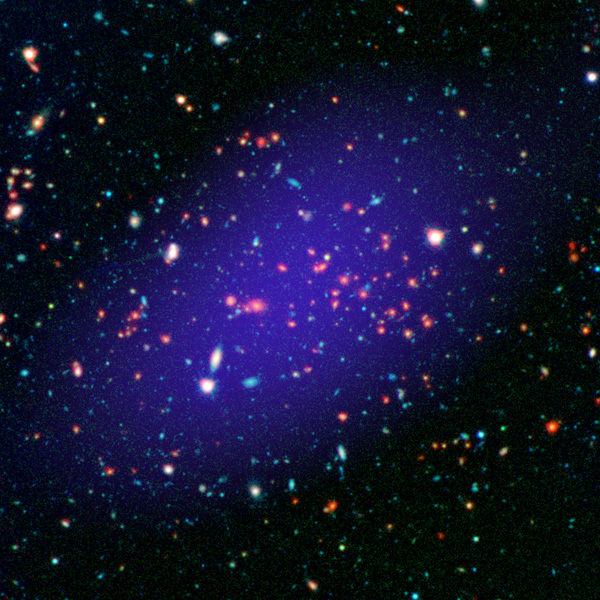
NASA astronomers announced this week (November 3, 2015) that they’ve discovered a giant gathering of galaxies – a gravitationally bound group of thousands of galaxies, each containing hundreds of billions of stars – in a very remote part of the universe. The galaxy cluster is known as MOO J1142+1527 (MOO stands for Massive Overdense Object). It’s located 8.5 billion light-years away and is the most massive structure yet found at such great distances. Astronomers spotted it with the help of two different orbiting observatories, the Spitzer Space Telescope and Wide-field Infrared Survey Explorer (WISE).
We’re seeing the newfound galaxy cluster as it existed 8.5 billion years ago, long before Earth formed. NASA said in a statement:
As light from remote galaxies makes its way to us, it becomes stretched to longer, infrared wavelengths by the expansion of space. That’s where WISE and Spitzer help out.
For infrared space telescopes, picking out distant galaxies is like plucking ripe cherries from a cherry tree. In the infrared images produced by Spitzer, these distant galaxies stand out as red dots, while closer galaxies look white. Astronomers first combed through the WISE catalog to find candidates for clusters of distant galaxies. WISE catalogued hundreds of millions of objects in images taken over the entire sky from 2010 to 2011.
They then used Spitzer to narrow in on 200 of the most interesting objects, in a project named the “Massive and Distant Clusters of WISE Survey,” or MaDCoWS. Spitzer doesn’t observe the whole sky like WISE, but can see more detail.
It was the combination of Spitzer and WISE that let astronomer narrow the field, from a quarter billion objects down to the most massive galaxy clusters in the sky. From these observations, MOO J1142+1527 jumped out as one of the most extreme.
MOO J1142+1527 may be one of only a handful of clusters of this heft in the early universe, according to the scientists’ estimates.
In the coming year, the astronomers who found this cluster plan to sift through more than 1,700 additional galaxy cluster candidates with Spitzer, looking for biggest of the bunch.
Bottom line: Astronomers have pinpointed a giant gathering of galaxies, located 8.5 billion light-years away. Known as MOO J1142+1527 (MOO stands for Massive Overdense Object), it’s the most massive structure yet found at such great distances.











